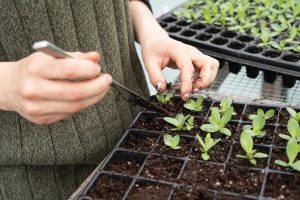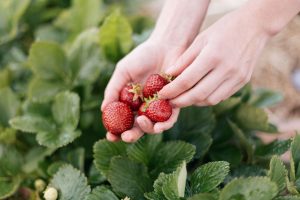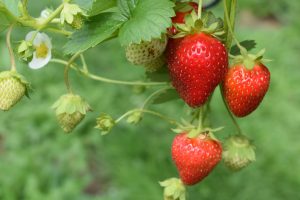Strawberries are one of the most widely produced crops in home gardens. Their sweet, juicy flavor makes them a delight to consume fresh or in numerous dishes.
Strawberries are tasty and contain vitamins, antioxidants, and other plant elements.
Learning From The Blog
Understanding the entire lifespan of strawberry plants helps cultivate strawberries effectively year after year.
We'll look at the intriguing stages of the strawberry plant life cycle, from seed to fruiting plant, in the sections below.
8 Growth Stages of Strawberry Life Cycle
1. Starting Point- Seeding The Fruit

Strawberries all begin as little seeds. The embryos of fresh strawberry plants await sprouting in these little, dried seeds.
Strawberry seeds develop within the fruits themselves. Small yellow seeds form on the meat's exterior as the fruits ripen. On average, each strawberry contains roughly 200 of these seeds.
The seeds are disseminated in the environment once the fruits are plucked or fall off the plant. Some strawberry fruits that fall to the ground decay and discharge their seeds. After eating strawberries, birds and other animals disperse seeds through their droppings.
Strawberry seeds are gathered from completely ripe fruits for commercial growing. The seeds are then properly dried and kept until planting time.
2. Germination
Seeds must first go through the germination process to sprout into strawberry seedlings. This entails the seed “waking up” from its latent state and starting to develop actively.
Several environmental variables must be present for strawberry seeds to germinate.
- First, they require adequate soil moisture levels. The seed coat absorbs water, allowing the embryo to enlarge and develop.
- Second, temperature is required to stimulate seed germination. Strawberry seed germination temperatures range from 68 to 86°F (20 to 30°C).
Germination will be delayed or prevented by cooler temperatures.
Also Read: Top 10 Delicious Florida Fruits You Must Try
3. The Seedling Phase
Young strawberry plants start an essential vegetative development phase once their seeds germinate successfully. The seedlings will actively produce leaves, roots, crowns, and branching runners.
What Happens At This Stage?
- Initially, new sprouting plants focus their efforts on developing a root system.
- This lays the groundwork for future expansion.
- Smaller lateral roots grow through the upper layers of soil, while a deep taproot penetrates downward.
- At the same time, leaves emerge from the developing shoot.
- These leaves can photosynthesize, generating food energy for the plant.
- As the ebecomes older, more leaves and new branches appear.
By this time, the base of the stem had expanded and developed into the crown of the strawberry plant. The leaves, roots, and runners will eventually emerge from this crown. The crown also stores food reserves for the plant to use later.
The strawberry plant putting out runners is an essential aspect of the vegetative phase. These are specialized stems that run parallel to the ground. Small leaves and nodes that can produce new root systems sprout along runners.
4. Flowering- A Gateway To Reproduction

Shorter days and milder temperatures in the autumn trigger strawberry plants to change from vegetative development to blooming.
The reproductive part of the strawberry life cycle begins at this point.
- In late summer or fall, tiny flower buds emerge from the tops of strawberry bushes. They emerge from the crowns rather than the long runners.
- The buds grow into little white blooms as they mature. Each one has five petals and a golden center with pollen and pistils.
Strawberry blossoms, interestingly, generally have both male and female components. As a result, most types are self-pollinating.
Also Read: Red Vs White Dragon Fruit
5. The Blossoming Period
- The initial blossoming period lasts roughly 2-3 weeks.
- However, not all blooms will be pollinated. Some will wither away if they are not utilized.
- Strawberries produce a second flush of blooms after the initial flush in early April.
- These unfold to reveal a spring flower show.
6. Pollination And Fertilization
Pollination occurs when pollen from the male portions of the strawberry flower is transported to the female pistil. This fertilizes the ovule inside the egg.
Pollen is moved between flowers by wind and insects. Bees are particularly crucial for cross-pollinating various strawberry kinds.
The best fruit production occurs when pollen is distributed from one plant to another. Self-pollination inside the same flower, on the other hand, works for strawberries.
How To Identify This Stage?
- After pollination, the fertilized ovules develop into full-fledged strawberry fruits.
- Each ovule develops into a separate seed on the fleshy fruit's exterior.
- From the time pollination occurs until ripe strawberries are ready to eat, it takes roughly 30-35 days. Warm, bright weather speeds up the maturation of the fruits.
7. Fruit Formation- Transforming Fertilized Flowers Into Berries
Following pollination, the base of the flower expands up at first. This produces a little green nub that develops into a strawberry.
Cells within the nub divide and grow during the following several weeks. Sugars and other chemicals are carried there, providing nutrients for development.
The nub gradually grows into a white, immature strawberry. It changes from a cone to a spherical berry.
As the fruits mature, they change from white to pinkish to a vivid crimson. This ripening indicates that the berries are about ready to eat.
Starches are converted into sugars during the last step of fruit development. Acids, vitamins, and aromatic compounds also form, producing a balanced sweet-tart strawberry flavor.
Also Read: 8 Promising Health Benefits of Avocados
8. Harvesting Time

Strawberry picking is best done in the morning when the dew has dried. Handle them carefully to avoid bruising or squashing.
- Look for whole, solid berries with a rich red color. Anything mushy, moldy, or partially green should be avoided. Ripe strawberries will readily separate from the stem.
- During peak season, try to harvest every few days. This prevents overripe fruits from decaying on the vines. Remove old berries as soon as possible to encourage fresh blossom formation.
Strawberries should be picked in tiny containers to avoid crushing. After harvesting, carefully place them in a refrigerated atmosphere.
Runners Enable Strawberry Reproduction And Propagation
Runners grow outward from the mother plant, looking for a place to root. When the tip of the plant comes into touch with the soil, it produces a new daughter plant. This is a genetically identical clone of the original.
A single strawberry plant can produce 10-15 new plants from runners by the end of the first year. The daughters then generate their runners, expanding the plant population enormously.
How To Avoid Them?
- Gardeners can prevent the spread of runners by pinching them off early.
- On the other hand, allowing some runners to thrive provides fresh plants for replanting.
Dormancy Keeps Birth To A New Cycle
Strawberry plants are not dead during dormancy; they are simply resting. The metabolic activity and hydration requirements are lowered. With colder temperatures, growth hormones disappear.

The plants channel their energy away from the leaves and runners towards the crown. Food reserves are accumulated there for future use.
Strawberry plants become more cold-tolerant when they become dormant. They can withstand colder winter temperatures better.
Dormancy allows plants to replenish their batteries. It prepares them for the massive energy expenditures of spring development and fruiting.
Check out our article on “Lemon Tree Growth Stages (A Detailed Guide)”
Final Thoughts
Strawberries have an intriguing cyclical lifetime that occurs every year. Seedlings develop into full plants after germination from seeds.
Through pollination and fruit development, these blooming plants generate luscious berries. Before the plants go dormant, runners produce new clones.
When spring arrives, strawberries emerge from hibernation to resume their robust growth and fruiting cycle.
Understanding the entire strawberry lifecycle helps home gardeners support the plants at each stage. This increases fruit production and yields lavish harvests.


![The Strawberry Life Cycle: From Seed to Fruit [Growth Stages]](https://www.wellnesspitch.com/wp-content/uploads/2023/10/Growth-Stages-of-Strawberry-Life-Cycle-750x375.jpg)





















